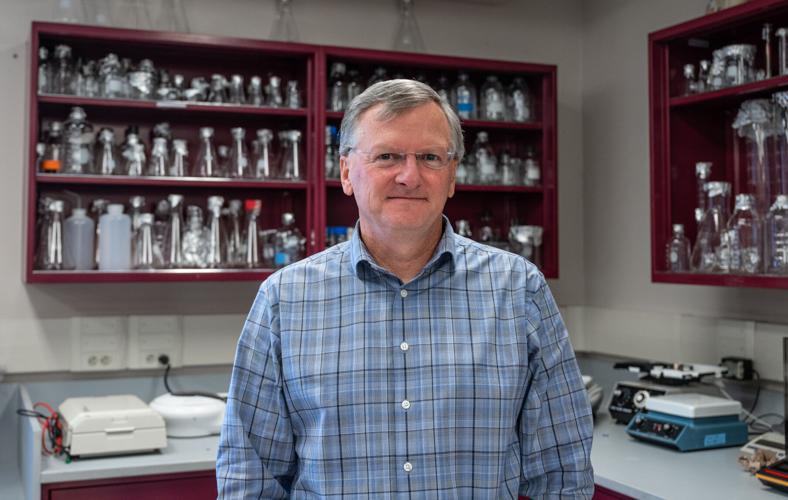
Jay Evans, the director of the University of Montana’s Center for Translational Medicine, stands in a laboratory in the Skaggs building where he researches vaccines on Oct. 27.
Opioid overdoses could become less likely thanks in part to new research being done at the University of Montana. In early 2024, a fentanyl vaccine, designed by University researchers in collaboration with Inimmune, a Missoula-based biotech company, will undergo phase one of human clinical trials.
During this early phase, the drug will be tested for its effectiveness at varying doses. Researchers are looking at what dose of the drug safely prevents fentanyl from crossing the blood-brain barrier — the main purpose of the vaccine. The $33 million needed to push the drug through phase one is being funded by the National Institute of Health.
According to the National Institute on Drug Abuse, fentanyl can cause death when the user’s breathing is slowed or stopped entirely, known as respiratory depression. During an overdose, the lack of oxygen to the brain can lead to death. The hope for the new vaccine, is to prevent fentanyl from crossing into the brain, making the drug have no “high” effect and, subsequently, no risk of overdose.
Jay Evans, director of the UM Center for Translational Medicine, said he can see this vaccine being given to addicts who are entering rehabilitative programs and to people who may be at high risk of accidental exposures, such as Drug Enforcement Agency officers or soldiers in areas of the world where the use of fentanyl as a weapon of chemical warfare is a concern.
Evans said although the team is also testing a heroin vaccine, which will begin phase one of trials in January, fentanyl is more applicable to Montana because it is more common than heroin.
More than 80,000 overdose deaths involved opioids in 2021, according to the NIH. The most commonly used opioid in these instances was fentanyl. In 2021 there were 62 fentanyl overdose deaths in Montana.
Fentanyl is also a threat to the community because it is commonly combined with other drugs such as heroin and cocaine to increase their potency, more so than other drugs, Evans said.
According to the NIH, this is dangerous because the user often doesn’t know fentanyl is in the drug they are taking. Because fentanyl is such a potent drug, it reacts differently from person to person due to a number of factors, such as tolerance for strong opioids, which makes it easy to overdose.
Alek Sweeden, 18, was 14 when he took what he thought was the anti-anxiety drug, Xanax. He and some friends had been using Xanax for a while and he took his usual “dosage” at the time.
He woke up 24 hours later with a limited memory of what had happened. Although he isn’t completely sure the pill was laced with fentanyl, he assumes he overdosed because of the effects he experienced.

Vials wait to be filled at one of the labs in the Skaggs building at the University of Montana on Oct. 26.
“It was one of the most terrifying experiences of my entire life,” Sweeden said. “There’s no way to know if something is fentanyl just by looking at it.”
The music education major from Denver underwent four months of wilderness therapy in Utah and then attended a therapeutic boarding school and residential treatment center in Trout Creek, Montana, called Explorations. Sweeden credits these programs with saving his life and supporting him through his journey. He is now four years clean.
Sweeden said he could see the new vaccine helping a lot of people.
“One way or another, you’re not going to be able to stop drug use, so you may as well mitigate risk,” Sweeden said.
Evans said high overdose rates show the urgency to develop this vaccine and help users fight their addictions. Fentanyl addiction isn’t a choice, he said, it is a disease that needs medical intervention like any other.
“If it was a choice, 90% of people that go into rehab wouldn’t relapse within two years,” Evans said.
Narcan, an opioid reversal drug, can be ordered for free from the Open Aid Alliance. The Alliance is a Missoula-based organization that provides health services to people “living with HIV, people experiencing substance misuse, and individuals who are homeless and or involved in the justice system,” according to the Alliance’s website.
Narcan, known medically as Naloxone, works by mimicking an opioid and blocking the opioid receptor in the brain. Naloxone is effective for 30 to 90 minutes, according to the NIDA, and some people may need multiple doses.
It is currently unknown how long the fentanyl vaccine will be effective in the body, but Evans said research suggests two to five years. The preventative benefit of the vaccine is something that stands out about it, he said, as it prevents overdose in the first place. Whereas with Narcan, one would have to have Narcan on hand to administer to the person who already overdosed.
The Center for Diseases Control and Prevention urges people to carry Narcan and keep it in their homes. According to CDCstatistics, someone else was present during almost 40% of overdose deaths. Had they had Narcan, the death could have potentially been prevented.
“Anyone can carry Naloxone, give it to someone experiencing an overdose and potentially save a life,” the CDC website said.
According to its website, signs of an overdose include: small “pinpoint” pupils, weak or no breathing, lack of consciousness, limp body, clammy skin, choking/gurgling sounds and discolored skin in areas such as the lips and nails.
Overdose reversal kits can be ordered from the Open Aid Alliance’s website. Narcan that are sprayed into the nose or as an injectable (similar to an EpiPen) are available.












